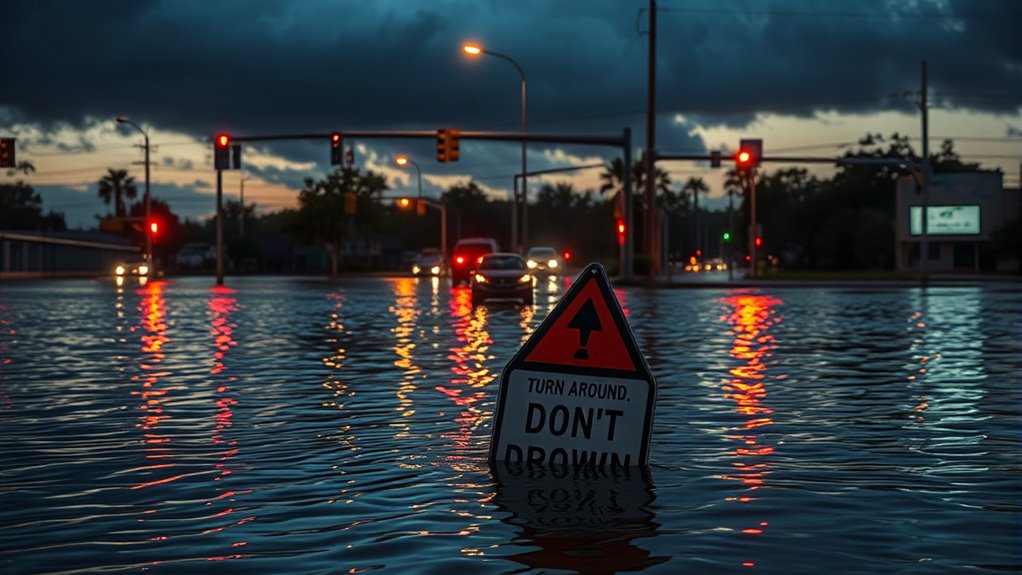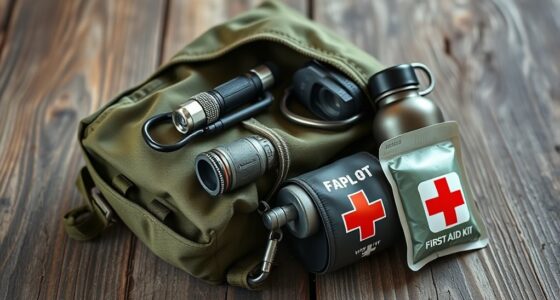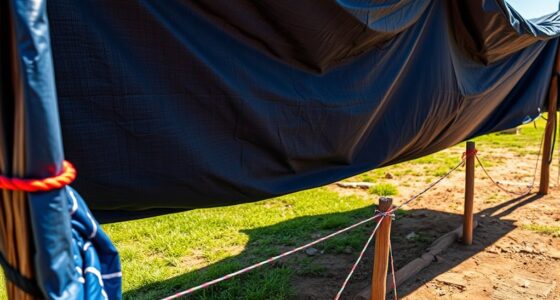During floods, it’s crucial to follow the “Turn Around, Don’t Drown” rule to stay safe. Never attempt to walk or drive through flooded streets, as water can hide dangers like downed power lines, debris, and sinkholes. Just a few inches of moving water can be powerful enough to sweep you away. Staying on dry ground helps prevent injury or worse. If you’d like to discover more about how to stay safe during floods, keep exploring these essential tips.
Key Takeaways
- Never attempt to walk or drive through floodwaters; just six inches of moving water can be dangerous.
- Follow evacuation orders promptly and seek higher ground when floods are imminent.
- Use the “Turn Around, Don’t Drown” rule to avoid risking life in flooded streets or roads.
- Recognize that floodwaters can hide hazards like downed power lines and debris.
- Stay informed through alerts and warnings to make safe decisions during heavy rains and floods.

Flood safety is essential because floods can strike suddenly and cause serious damage. When you understand how to stay safe, you help protect yourself and others from the dangers of rising water. One of the most effective ways to prevent tragedy is by recognizing the importance of urban planning in flood-prone areas. Good urban planning involves designing cities with proper drainage systems, flood barriers, and green spaces that absorb excess water. These measures reduce the likelihood of water overwhelming streets and homes, making communities safer during heavy rains. As a resident, you should stay informed about your area’s flood risk and advocate for responsible urban development that prioritizes flood mitigation. Incorporating proper planning strategies can significantly enhance community resilience to floods. Emergency preparedness plays a crucial role in flood safety. Being prepared means knowing what to do before, during, and after a flood. Keep an emergency kit stocked with essentials like water, non-perishable food, medications, and important documents. Have an emergency plan that includes knowing your evacuation routes and designated safe spots. Staying aware of weather alerts and flood warnings through local news or weather apps is vital, so you can act quickly when necessary. When a flood warning is issued, don’t wait until water begins to rise; evacuate immediately if advised. Remember, the principle of “Turn Around, Don’t Drown” is critical—if you see water covering the road, don’t try to drive through it, even if it looks shallow. Just a small amount of water can sweep your vehicle away or cause it to stall, putting you at risk. Your actions also affect how well your community responds to flooding. Support local efforts to improve urban planning and flood defenses. Volunteer for community drills or educational programs that teach flood safety and emergency preparedness. Being proactive by sharing flood information with neighbors and family helps everyone stay aware and ready. During floods, avoid crossing flooded streets on foot or in vehicles. Water can hide hazards like downed power lines, sinkholes, or sharp debris, making it dangerous to attempt crossing. Remember that even a few inches of moving water can knock you over or carry your vehicle away.
Frequently Asked Questions
How Can I Prepare My Family for Flood Emergencies?
To prepare your family for flood emergencies, create an evacuation plan that includes multiple routes and a designated safe meeting spot. Stay informed by signing up for flood warning systems in your area, so you receive alerts promptly. Practice your plan regularly with your family, and prepare an emergency kit with essentials. Staying proactive guarantees everyone knows what to do, reducing risks during a flood.
What Should I Include in a Flood Emergency Kit?
Did you know that having a well-stocked flood emergency kit can make a huge difference during a flood? Your kit should include flood safety supplies like bottled water, non-perishable food, flashlights, batteries, and a first aid kit. Don’t forget emergency communication tools such as a portable phone charger and a radio. Having these essentials prepared guarantees you stay safe and informed when floodwaters rise unexpectedly.
Are Flood Insurance Policies Worth the Cost?
Yes, flood insurance is worth the cost because it provides essential financial protection if your property is damaged. Standard homeowners’ policies often don’t cover flood damage, leaving you vulnerable. Investing in flood insurance helps you recover faster and minimizes financial strain after a flood. If you live in a flood-prone area, it’s a smart, proactive step to safeguard your home and belongings.
How Do I Help Neighbors During a Flood?
Think of your neighborhood as a ship steering stormy waters—you’re all in this together. To help neighbors during a flood, foster community cooperation by checking on vulnerable residents and sharing emergency communication plans. Offer assistance with evacuations or supplies, and stay informed through local alerts. Your proactive kindness can be the lighthouse guiding others safely ashore, making sure no one feels lost in the chaos.
What Are Signs of a Flood-Warned Area?
You can tell a flood-warned area by paying attention to flood warning systems, which often include sirens, alerts, and official notices. Check flood zone maps to see if your property is in a high-risk area. When these systems activate or maps indicate a flood zone, it’s a clear sign that you should stay alert, prepare to evacuate, and avoid low-lying areas prone to flooding.
Conclusion
Remember, flood safety is your lifeline in the chaos. When you see floodwaters, don’t take chances—turn around, don’t drown. Even a few inches of moving water can sweep you away faster than you can blink. Protect yourself and your loved ones by following these simple principles. Stay alert, stay safe, and don’t let a moment of hesitation turn into a tragedy. Your quick actions could be the difference between life and death—don’t risk it.









